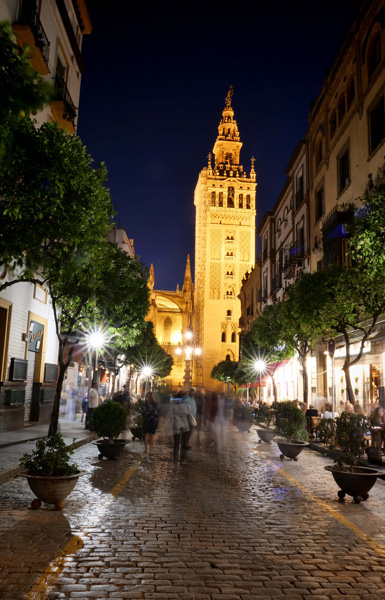
by successfulbob | architectural photography, Guest Post, Lumix G9, travel photography
Seville, Spain – Travel with Ken MacAdams Part Three
A few blocks away from the Alcazar is the Hospital de la Caridad, a 17th-century charity hospital which served as a place of final refuge for Sevilla’s poor and homeless. The hospice and hospital were founded in 1626 by Don Miguel Manara, a one-time playboy who in later life had a change of heart and spent his last years dedicating his life to strict worship and taking care of the poor.
 This was the “small” chapel at the Hospital de la Caridad. Statues, period artwork, and Dutch tile scenes graced the courtyards of the hospital.
This was the “small” chapel at the Hospital de la Caridad. Statues, period artwork, and Dutch tile scenes graced the courtyards of the hospital.
Inside you’ll find Italian statues (his wealthy family was from Italy) and Dutch tiles from Delft, depicting scenes from the Old and New Testament, a reminder that the Netherlands was under Spanish rule in centuries past.
Walk a few crooked blocks, and you’ll find yourself at the Plaza de Toros, or the bullfighting ring and museum. Guided tours take you through the empty arena, its museum, and the chapel where the matadors pray before the fight. Bullfighting still takes place here from May to September. Novice bullfighters take the ring on Thursday evenings in July. Serious bullfighters, the professionals, fight on special events and holidays, and these events often sell out in advance.

A handheld (no tripods allowed) shot of a Flamengo dancer at a sold-out performance along one of the back streets in the Jewish Quarter, adjacent to the Alcazar area.

A typical street cafe and tapas bar scene. Note the inlaid tile work on the building on the left.
Flamenco, the dance that embodies the spirit of southern Spain, can be found in numerous locations and barrios nightly. Some of the establishments offer flamenco lessons, while others house exhibits of flamenco costumes and other artifacts.
A part of any visit to Seville is sampling the cuisine. Some feel the time spent sitting at an outdoor street cafe, savoring tapas and a bottle of wine, is as important as visiting the great city sights! Tapas are small portions of seafood, salads, meat-filled pastries, and other delicious bites. Tapas bars can be found in all areas of the city, and every local has their favorite!

Twenty-five-second nighttime exposure of the Giralda Bell Tower, a stunning landmark of Sevilla.
Oozing with Old World Charm, Seville is a destination in Spain not to be missed. Allow two days to see the main sights, and linger longer if possible! When you’re finished, head on to Andalucia’s White Hill Towns for your next over-the-top Spanish experience!
Ken has always loved to travel, so when he made a common connection with the fact that either a long day pounding the streets of some foreign city, or shooting the last dance at a wedding, a good part of his physical

weariness came from lugging around his big heavy DSLR. That’s when he started looking at alternatives – and ended up selecting Panasonic Lumix Micro Four Thirds gear.
Ken is rarely without a camera, and the next great photo travel experience – whether local or abroad – is always in the back of his mind! A longtime resident of the Four Corners, and when he’s not out on the road, he enjoys some of the great outdoor opportunities found there – mountain biking, hiking, and Jeeping.
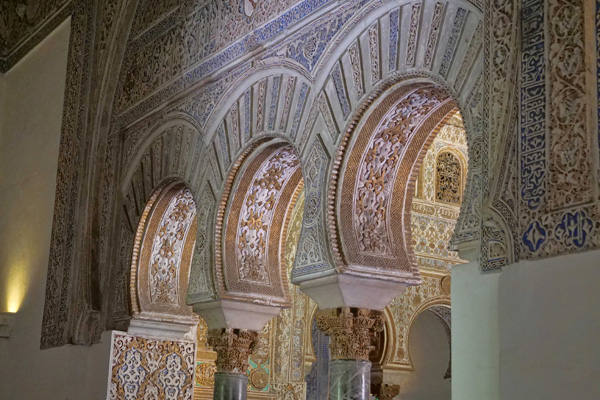
by successfulbob | architectural photography, Guest Post, Lumix G9, travel photography
Seville, Spain – Travel with Ken MacAdams Part Two
No visit to Seville is complete without a visit to the Royal Alcazar. Originally a 10th-century palace for the governors of the local Moorish state, this is Europe’s oldest still in use palace. Rebuilt in the 14th century by the Christian king Pedro I (by Muslim workmen), it features spectacularly decorated halls, courtyards, and gardens.

In the Garden Pool was a small statue of Mercury. This pool was fed by a 16th-century aqueduct.
There are distinctive Islamic-style flourishes seen in the archways, walls, and ceilings. As you enter, you’ll pass a rough stone wall, remnants of an older Moorish fortress, circa A.D. 913.

This image shows the painstaking attention to detail recorded on the walls and ceiling of the Hall of Ambassadors. All photos in this post © Ken MacAdams
In the Admiral’s Hall, Columbus recounted his travels, and Ferdinand Magellan planned his around-the-world venture. Queen Isabella realized Columbus’s New World discoveries could be big business. Here resides a model of Columbus’ flagship, the Santa Maria. In the center of King Pedro’s palace is the Courtyard of the Maidens, a big courtyard with a long pool in the center.

The Moorish doorways were left intact by the Reconquista Christians. Note the intricate detail in each arch.
Feeling his Alcazar a bit stark, the king hired Muslim workers from Granada – home to the famed Alhambra – to recreate its romance. This palace is considered by some as Spain’s best example of the Mudejar style. Subsequent kings, Philip II, and Charles V added their touches throughout the palace.
Seville, Spain part three Next Friday.
Ken has always loved to travel, so when he made a common connection with the fact that either a long day pounding the streets of some foreign city, or shooting the last dance at a wedding, a good part of his physical

weariness came from lugging around his big heavy DSLR. That’s when he started looking at alternatives – and ended up selecting Panasonic Lumix Micro Four Thirds gear.
Ken is rarely without a camera, and the next great photo travel experience – whether local or abroad – is always in the back of his mind! A longtime resident of the Four Corners, and when he’s not out on the road, he enjoys some of the great outdoor opportunities found there – mountain biking, hiking, and Jeeping.
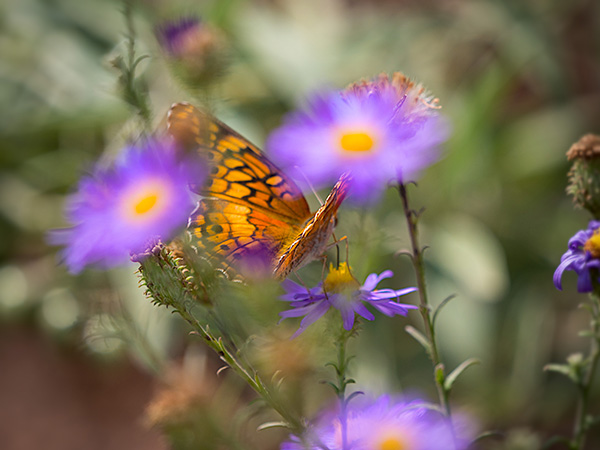
by successfulbob | bird photography, flower photography, Lumix G9, photo walkabout, photography, photography gear, wildlife photography
Long Lens Photography – 100-400mm
I enjoy my long lens for outdoor photography. It’s a beautiful piece of equipment for isolating subjects against a background with nice bokeh. The longer the lens, the easier it is to have an out-of-focus background. The PANASONIC LUMIX G Leica DG Vario-Elmar Professional Lens, 100-400MM, F4.0-6.3 ASPH is a magical lens IMHO.
Here are some images from a walkabout at the Sedona Wetlands. I didn’t find many waterfowl as it was midday and possibly the wrong time of year. In any case, I always try to make the best of any photography situation and started looking for details. There are still some wildflowers scattered throughout. This attracts butterflies, birds, and bees.
 Adult female Lesser Goldfinch snacking on some wildflowers that have gone to seed
Adult female Lesser Goldfinch snacking on some wildflowers that have gone to seed
 I always look to capture ‘behavior’ photos as well as straight portraits of my feathered friends. Here the Lesser Goldfinch is working to get the seeds free from the plant.
I always look to capture ‘behavior’ photos as well as straight portraits of my feathered friends. Here the Lesser Goldfinch is working to get the seeds free from the plant.
 Butterfly caught with shallow depth of field between the plants.
Butterfly caught with shallow depth of field between the plants.
The butterfly photo was my favorite photo of the day. If you’ve chased butterflies in the wild, you know how difficult it can be to get an interesting image. I tracked this one for a while and looked to ‘sandwich’ the butterfly with DOF. I wanted a sharp subject surrounded by the in and out of focus flowers. This was made more difficult as there were not a ton of flowers in bloom and the wind was making the flowers dance as well. Now that I see the image here I’ll crop in a little tighter and loose the past prime flowers on the right-hand side of the photo.
 Wasps one of our other pollinators were flitting between the blooms as well as the butterflies.
Wasps one of our other pollinators were flitting between the blooms as well as the butterflies.
I choose this one to share as it has a different color with black and white stripes.
Back to the lens. One complaint I hear about the lens is that it is very stiff to zoom. It was designed that way not to suffer ‘lens creep’ when you hang it from your shoulder. I’ve found a perfect way to change the zoom. Instead of trying to turn the lens, hold the lens and turn the camera. It’s like opening a bottle of champagne where you hold the cork and twist the bottle. Makes it easy and you don’t end up with the lens creep!
When paired with the Lumix G9 you get 6 and a half stops of handholdability. All images were handheld in this post.
Yours in Creative Photography, Bob
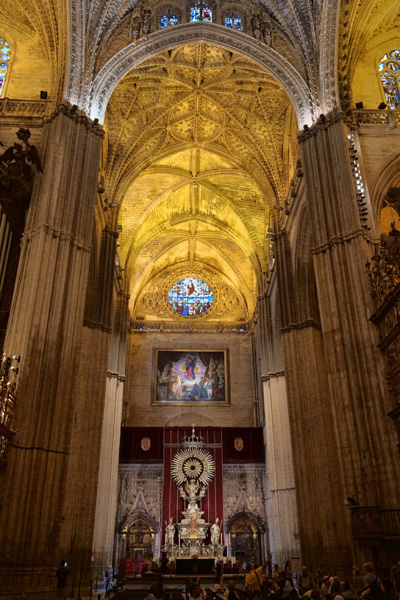
by successfulbob | architectural photography, Guest Post, Lumix G9, travel photography
Seville Spain – Travel with Ken MacAdams
Ken shares his travel photography and stories here on Successful-Photographer as he has in the past. Ken’s camera of choice is Panasonic’s flagship stills camera the Lumix G9 with the Leica DG Vario-ELMARIT Professional Lens, 12-60MM, F2.8-4.0
Seville shines as one of Spain’s magnificent stars. Activities include attending a bullfight, standing in awe at the immensity of the world’s largest Gothic church, or going shoulder to shoulder with the crowds in the Reales Alcazar, a beautiful Moorish style palace. In the 16th century, Seville was the gateway to the New World. Explorers Vespucci and Magellan sailed from its great river harbor, discovering new trade routes and abundant sources of gold, silver, cocoa, and tobacco. In the 17th century, it was Spain’s largest and wealthiest city.
 Protected by a Renaissance wrought-iron grill, it was impossible to stand on-center of the High Altar to photograph this 65 foot tall altar. All Photos in this post © Ken MacAdams
Protected by a Renaissance wrought-iron grill, it was impossible to stand on-center of the High Altar to photograph this 65 foot tall altar. All Photos in this post © Ken MacAdams
 The tomb of Christopher Columbus is carried by four kings.
The tomb of Christopher Columbus is carried by four kings.
Seville’s Cathedral is the third largest church in Europe. It rises from the site of a mosque that was torn down in 1401 to make way for the cathedral, one that the Reconquista Christians said would be the largest in the world. Past the immense pipes of the church’s pipe organ is the High Altar, protected by a wrought-iron Renaissance grille. Standing 65 feet tall, there are 44 scenes from the life of Jesus and Mary, all carved from walnut and chestnut – blanketed by a staggering amount of gold leaf.
 In this image you can see the immense floor to ceiling scale of the church. Set on AWB, the Lumix G9 was able to correctly register the different color tones of the interior lighting.
In this image you can see the immense floor to ceiling scale of the church. Set on AWB, the Lumix G9 was able to correctly register the different color tones of the interior lighting.
The work, finished in 1564, took three generations to complete. Opposite from the Altar de Plata, is the Tomb of Columbus. Located in front of the cathedral’s entrance for pilgrims are four kings who bear the remains of Christopher Columbus upon their shoulders. Identified by their team shirts, the pallbearers represent the regions of Castile, Aragon, Leon, and Navarre. A walk through the Treasury reveals gold and silver reliquaries, and Spain’s most valuable crown, the jeweled Corona de la Virgen de los Reyes. Attached to the church is the Giralda Bell Tower, a former minaret. If you have the time – or energy – you can climb the 330 feet up to its top for a grand city view.
 The pool within the courtyard served a dual purpose – besides beauty, it helped cool the surrounding rooms of the palace during the hot summer days.
The pool within the courtyard served a dual purpose – besides beauty, it helped cool the surrounding rooms of the palace during the hot summer days.
Look for more on Seveille, Spain and the Royal Alcazar from Ken next Friday!
Ken has always loved to travel, so when he made a common connection with the fact that either a long day pounding the streets of some foreign city, or shooting the last dance at a wedding, a good part of his physical

weariness came from lugging around his big heavy DSLR. That’s when he started looking at alternatives – and ended up selecting Panasonic Lumix Micro Four Thirds gear.
Ken is rarely without a camera, and the next great photo travel experience – whether local or abroad – is always in the back of his mind! A longtime resident of the Four Corners, and when he’s not out on the road, he enjoys some of the great outdoor opportunities found there – mountain biking, hiking, and Jeeping.
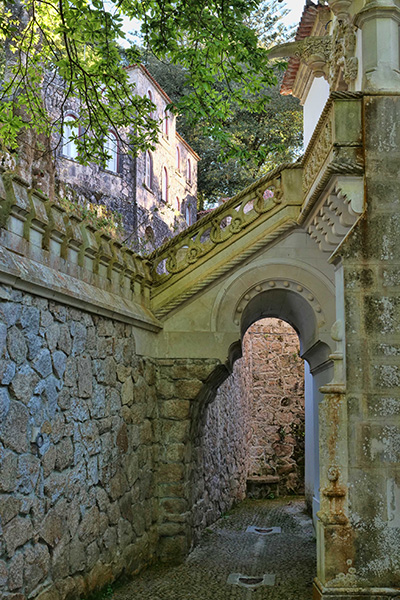
by successfulbob | cityscape photography, Guest Post, Lumix G9, travel photography
Sintra, Portugal – Guest Post Part Two
by Ken MacAdams
Ken shares his travel photography and stories here on Successful-Photographer as he has in the past. Ken’s camera of choice is Panasonic’s flagship stills camera the Lumix G9 with the Leica DG Vario-ELMARIT Professional Lens, 12-60MM, F2.8-4.0
Take it away Ken. Start with part one of this story here.
A five minute walk downhill brought me to my second stop, the Moorish Castle. The castle was constructed during the 8th and 9th centuries, during the period of Muslim Iberia. The castle was centrally located in an area that was primarily agricultural, and was necessary for protection of the residents. It was a strategic point during the Reconquista, but was taken by Christian forces after the fall of Lisbon in 1147. Settlers occupied the castle during the 12th and 13th centuries, but its military importance was progressively diminishing, and inhabitants were abandoning the castle for the old village of Sintra. In the beginning of the 15th century a small group of Jews occupied the castle until being expelled from the country by Manuel I of Portugal.

Inside the Moorish Castle. These walls match the terrains ups and downs with lots of archery vantage points. In ancient days, they would have cleared the trees around the outside of the compound so attackers had no shelter. Images in this post © Ken MacAdams
The 1755 Lisbon earthquake caused considerable damage to the chapel and castle. It wasn’t until King Ferdinand II began work on the Pena Palace around 1840, that he took up the task of improving the condition of the old Moorish Castle and walls. The castle is built on very rugged terrain with slopes reaching 40% gradients. The hike around the castle walls is bound to elevate your pulse! A stop at each watchtower allows you to catch your breath and enjoy the magnificent views.

Secluded archway leading to the palace. Examine the rope detail on the sides of the stairs.
Having navigated the castle walls, I retraced my steps – also uphill – to where I’d parked the car. Returning to back to Sintra, I visited the Quinta da Regaleria. This highly decorated, ornate Gothic styled, multi-story 20th century residence is situated in Old Town. The original house dates back to the 1800’s. Over the years, subsequent owners have made renovation, the most recent being about 1904, when carved gargoyles, Gothic turrets, exotic woodwork and other ornate features were added. Additions by an Italian architect evoked Roman, Gothic, Renaissance, and Manueline styles. Located within the park is the palace and chapel, and a luxurious park with walkways, lakes, grottoes, wells, benches, statues, and fountains.

The Quinta da Regaleria palace and stature gardens.
The true wonder of the Quinta da Regaleria are the grounds, which were inspired by the owner’s mystic ideologies. Hidden within the grounds are references to the Knights Templar, the Masons, and dark alchemy. The well, one of the strangest features, has a concealed circular passageway that descends 88 ft. downward, then connects to a series of tunnels that run the length of the garden. The well symbolizes the initiation ceremony for the Knights Templar. As you walk through the gardens, you’re also awarded occasional glimpses of the Moorish Castle and Pena Palace high up on the mountain above you.
I’d packed all three sights into one day, so my feet were happy to settle into a comfy booth at one of downtown Sintra’s cafes! Shortly thereafter, I returned to the villa, and enjoyed a quiet nights’ sleep.
Ken has always loved to travel, so when he made a common connection with the fact that either a long day pounding the streets of some foreign city, or shooting the last dance at a wedding, a good part of his physical

weariness came from lugging around his big heavy DSLR. That’s when he started looking at alternatives – and ended up selecting Panasonic Lumix Micro Four Thirds gear.
Ken is rarely without a camera, and the next great photo travel experience – whether local or abroad – is always in the back of his mind! A longtime resident of the Four Corners, and when he’s not out on the road, he enjoys some of the great outdoor opportunities found there – mountain biking, hiking, and Jeeping.
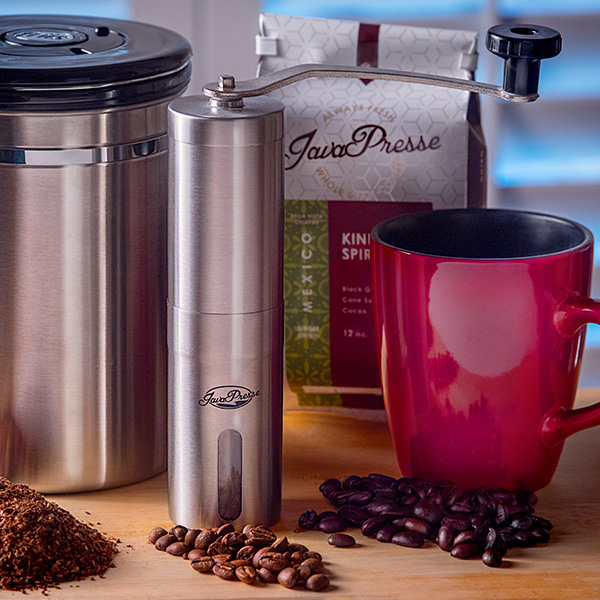
by successfulbob | commercial photography, Lumix G9, photography, photography creativity, photography education, photography gear, photography lighting resources
Java Presse – Coffee Shoot
The Genesis of a Commercial Shoot
Not quite ‘nectar of the gods’ but I’ve found some serious joy in my morning coffee. It was a gradual process to see the pleasure I now have in the morning ritual and enjoyment of grinding beans, brewing and enjoying coffee.
 Java Presse Coffee image square format final crop
Java Presse Coffee image square format final crop
It started with some friends showing the benefits of grinding beans for French Press coffee. Good stuff.
I found myself getting frustrated with the ‘static cling’ that was generated by using an electric grinder that had a plastic bin for catching the grounds and left little trails of tiny grounds scattered along the counter. This led to looking for a mill that had a stainless steel basket. Research showed that prices were more than I wanted to pay. Which turned out to be a good thing! Because that led me to the stainless steel coffee grinder from Java Presse.
The grinder led me to lots more information about the whole process of roasting coffee, the freshness of the beans and proper preparation for the French Press that I use. Thanks to Java Presse the entire experience has turned my morning coffee into an enjoyable ritual. And who knew that freshly roasted beans, ground fresh just before brewing could make such a difference.
I’m a coffee convert.
Photography Process
And, now on the photography section of the making of a commercial image of the product. You can see the final photo at the top of the post above. Below is how the photo was built.
Good, solid commercial images should look effortless and clean. It takes a bit more to achieve the look. I make this happen by creating several images with different lighting patterns which are later combined in Adobe Photoshop. This comes in handy for items that have different levels of reflectance such as the stainless steel of the grinder and coffee storage container as well as making sure logos are readable.
 Note the harsh light patterns in the metal especially the one crossing through the logo on the grinder
Note the harsh light patterns in the metal especially the one crossing through the logo on the grinder
 Using a reflector I reshot the scene to give more pleasing light on the stainless steel, but now the reflections that give the image life are gone
Using a reflector I reshot the scene to give more pleasing light on the stainless steel, but now the reflections that give the image life are gone
 See the difference between the two blended images. Logos are a much easier read, and there are highlights right where they are needed without distraction
See the difference between the two blended images. Logos are a much easier read, and there are highlights right where they are needed without distraction
 Photoshop Layers Palette is showing some of the work with Masks used to help create the final image.
Photoshop Layers Palette is showing some of the work with Masks used to help create the final image.
I also used Skylum software (formerly MacPhun) software called Focus CK. CK stands for Creative Kit. It is a very handy sharpening and blurring tool for directing attention where you want. I often use the ‘Macro’ setting on its layer and mask in what I need.
Yours in Creative Photography, Bob
PS – Here’s the gear I used in this shoot.
2 Fiilex LED lights with softboxes
Lumix G9
LUMIX G X VARIO LENS, 35-100MM, F2.8 ASPH
White foam core panel
Posing table
Tripod Necessary for keeping images in registration for compositing the lighting
Ball head for tripod – Siri Model K-20X

 This was the “small” chapel at the Hospital de la Caridad. Statues, period artwork, and Dutch tile scenes graced the courtyards of the hospital.
This was the “small” chapel at the Hospital de la Caridad. Statues, period artwork, and Dutch tile scenes graced the courtyards of the hospital. A handheld (no tripods allowed) shot of a Flamengo dancer at a sold-out performance along one of the back streets in the Jewish Quarter, adjacent to the Alcazar area.
A handheld (no tripods allowed) shot of a Flamengo dancer at a sold-out performance along one of the back streets in the Jewish Quarter, adjacent to the Alcazar area. weariness came from lugging around his big heavy DSLR. That’s when he started looking at alternatives – and ended up selecting Panasonic Lumix Micro Four Thirds gear.
weariness came from lugging around his big heavy DSLR. That’s when he started looking at alternatives – and ended up selecting Panasonic Lumix Micro Four Thirds gear.





























